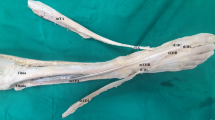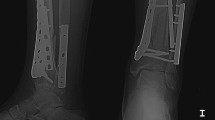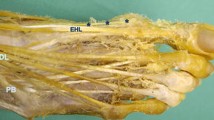Abstract
Purpose
The presence of supernumerary heads in the Adductor Hallucis (AddH) muscle represents a rare variant of plantar muscle variation that may exhibit divergent clinical manifestations in affected individuals. Clinical presentations may include progressive foot or heel pain, paresthesias, foot discomfort, limited range of motion in the mid/hindfoot regions, hallux vagus/varus deformity, and articular abnormalities.
Methods
In this case, a unique variation of the AddH was presented in a female cadaver, along with a literature review. The variation was characterized by the atypical attachment of several fibers to the intermuscular septum, and it was found that the cadaver had two-headed AddH muscles on both sides, with medial and lateral heads.
Results
The present case showed that the medial part of the Oblique Head (OH) blended with the tendon of the Flexor Hallucis Brevis (FHB), while the lateral part met with the tendon of the Transverse Head (TH). The origin of OH different than the previous types, while the origin site of TH was classified as type B. In contrast to previous reports, the medial and lateral heads of OH were recorded on both sides.
Conclusion
The varied organization of both heads and the location of AddH muscles may be attributed to various combinations of primordial muscles or anomalies during embryological development. Therefore, the variations and types of AddH should be taken into account during foot surgery.




Similar content being viewed by others
Data availability
Not applicable.
References
Akita K, Sakamoto H, Sato T (1999) Lateromedial and dorsoplantar borders among supplying areas of the nerves innervating the intrinsic muscles of the foot. Anat Rec 255(4):465–470
Arakawa T, Sekiya S, Kumaki K, Terashima T (2006) Intramuscular nerve distribution pattern of the oblique and transverse heads of the adductor hallucis muscles in the human foot. Anat Sci Int 81(3):187–196
Arakawa T, Tokita K, Miki A, Terashima T (2003) Anatomical study of human adductor hallucis muscle with respect to its origin and insertion. Ann Anat 185(6):585–592
Bejjani FJ, Jahss MH (1986) Le Double’s study of muscle variations of the human body part II: muscle variations of the foot. Foot Ankle 6(4):157–176
Bergman R (2016) Bergman’s Comprehensive Encyclopedia of Human Anatomic Variation. 1st edition ed, ed. R. Tubbs, M. Shoja, and M. Loukas. Wiley Blackwell. 1456.
Cunningham DJ (1882) Report on some points in the anatomy of the Thylacine (Thylacinus cynocephalus), Cuscus (Phalangista maculata) and Phascogale (Phascogale calura). Vol. 5: Longmans.
Henle J (1855) Handbuch der systematischen Anatomie des Menschen, vol 3. Druck und Verlag von Friedrich Vieweg und Sohn, Braunschweig
Kura H, Luo Z-P, Kitaoka HB, An K-N (1997) Quantitative analysis of the intrinsic muscles of the foot. Anat Rec 249(1):143–151
Le Double A-F (1897) Traité des variations du système musculaire de l'homme et de leur signification au point de vue de l'anthropologie, zoologique v. 2. Vol. 2: Schleicher frères.
Macalister A (1875) Additional observations on muscular anomalies in human anatomy (third series) with a catalogue of the principal muscular variations hitherto published. Proc Roy Irish Acad 25(1):1–134
Martin B (1964) Observations on the muscles and tendons of the medial aspect of the sole of the foot. J Anat 98(Pt 3):437–453
Ogut E (2022) The Stieda process of the talus: the anatomical knowledge and clinical significance of an overlooked protrusion. Bulletin of the National Research Centre 46 (1).
Owens S, Thordarson DB (2001) The adductor hallucis revisited. Foot Ankle Int 22(3):186–191
Prenant M (1891) Contribution a la connaissance de anomalies musculaires. Bull. De la Soc. des Sciences de Nancy: 85.
Acknowledgements
The authors sincerely thank those who donated their bodies to science so that anatomical research could be performed. Results from such research can potentially increase mankind's overall knowledge, improving patient care. Therefore, these donors and their families deserve our highest gratitude.
Funding
The study has no financial or personal relationship with any third party whose interests could be influenced positively or negatively by the article’s content. This research did not receive any specific grant from funding agencies in the public, commercial, or not-for-profit sectors.
Author information
Authors and Affiliations
Contributions
OE: supervision, project development, data collection, manuscript writing. AZ: data collection. The authors described their own experience and all authors read and approved the final manuscript.
Corresponding author
Ethics declarations
Conflict of interest
The authors declare that they have no conflict of interest.
Ethical approval
Ethics approval is not required for this case report on commercially available human cadavers, cadaver parts and other biological materials.
Consent to participate
Not applicable.
Consent to publication
All authors consent for publication.
Informed consent on studies with human and animal subjects
Not applicable.
Additional information
Publisher's Note
Springer Nature remains neutral with regard to jurisdictional claims in published maps and institutional affiliations.
Rights and permissions
Springer Nature or its licensor (e.g. a society or other partner) holds exclusive rights to this article under a publishing agreement with the author(s) or other rightsholder(s); author self-archiving of the accepted manuscript version of this article is solely governed by the terms of such publishing agreement and applicable law.
About this article
Cite this article
Ogut, E., Askin, Z. Extra heads of Adductor Hallucis muscle and an atypical attachment of several fibers: a case report. Surg Radiol Anat 45, 923–931 (2023). https://doi.org/10.1007/s00276-023-03167-y
Received:
Accepted:
Published:
Issue Date:
DOI: https://doi.org/10.1007/s00276-023-03167-y




